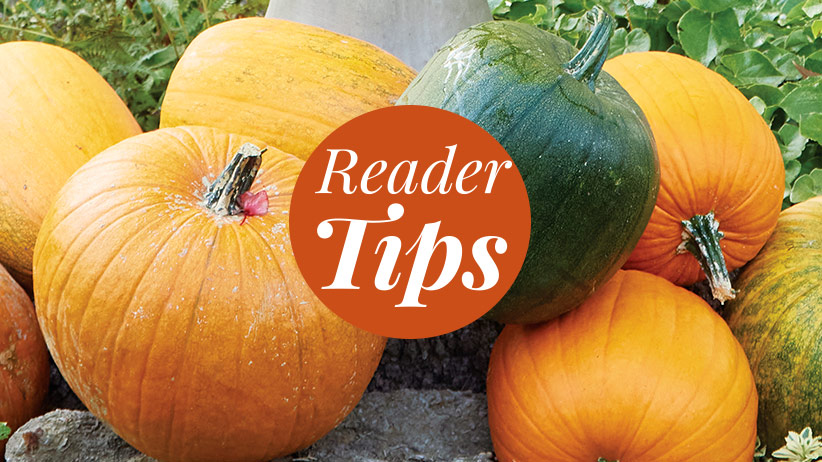
Small garden with big impact
If you were walking down a sidewalk in British Columbia and happened upon this beautiful garden, I can guarantee you would stop to take a closer look. There’s a lot going on in this small space. And if you noticed owner Susan Koelink working outside, you’d probably want to ask her some questions. Would you ask the name of those starbursts in the center of the border? Would you want to know how she gets so many good-looking plants in a garden that’s only 70 feet wide and 35 feet deep? Maybe you’d just want to tell Susan how much you enjoy walking past her garden in every season. Let’s take a tour, and we’ll find answers to these questions and more.

Be bold with color
By contrasting two colors, like the shrimp pink of the door and the chartreuse euphorbias (Euphorbia spp.) framing the steps, you can pull off some really unique combinations. Repetition is another great use of color. See the purple smokebush (Cotinus coggygria) in front of the left window? Touches of purple and burgundy like this help tie the garden to the purple gate and the peak over the door.
You Might Also Like:
Watch Our New Talk & Tour with Susan Koelink!
How to Use Repetition in Garden Design
Secrets to Designing Colorful Flower Borders

An invitation to enter the garden
It always pays to start with a good design. In a small garden like this, your temptation might be to leave as much lawn as possible to simplify maintenance or do away with grass completely and fill the garden with shrubs and perennials. But this design has struck a happy medium. There’s enough grass for visitors to stand and view the garden. Yet there’s lots of space for plants that, in many gardeners’ opinion, are much more interesting than grass. And that small bit of smooth green lawn on both sides of the garden provides a frame for all of the shrubs, perennials and bulbs.
Curved beds lead the eye
Walk through the gate and turn to the left. A gently curving edge like this along the planting bed leads your eyes, directing you to the backyard. Notice how crisply the flower beds have been edged and mulched above? If you have a small garden, maintenance is important because you see everything up close. There are no distant vistas where you can fudge on maintenance. A sharp spade, used several times a year, is the way to keep bed edges neat.

You can get a bit of privacy even in a front yard
If you turn right past the gate instead of left, you’d discover a narrow brick path. It’ll take you to the shady, secluded corner in the photo above. There are several ways you can make a private retreat more secluded. First, tone down its hardscaping. These bricks are mostly mossy — it’s a more subtle path than bright-red bricks would be. Second, you can narrow the entrance. The big hellebore (Helleborus spp.) on the left and the hosta (Hosta hybrids) on the right almost obscure this path. And a light-green full moon maple (Acer japonicum) and a saucer magnolia (Magnolia x soulangeana) help screen the view at eye level and above. Add a comfortable place to sit and you have a perfect hideaway in your own front yard.
You Might Also Like:
DIY Privacy Screen Project
Classic Garden Project Woodworking Plans
Garden Edging Tips from 4 Regional Pros

Creative plant combinations
I bet you’re thinking it’s the plant selection that really makes this garden. I’ll agree with you — from the minute you come up the sidewalk, you’re greeted with gorgeous and creative combinations. Let’s take a look at some of these unique plantings.
Choose plants that fit the situation
Try to select plants that will fit the growing conditions you have or you’ll spend all of your time babying them along. The euphorbias, thyme (Thymus spp.) and alliums (Allium schubertii) above are perfect choices for this raised area because it’s dry there and they don’t require lots of water to keep them growing.

Give plants room to breathe
Want to know how to achieve the lush, yet uncrowded combinations you see here? Start by studying the ultimate sizes of the plants you want. See the hellebore (Helleborus spp.) between the ferns and a red astrantia (Astrantia spp.)? If you crowd them for a full look when you plant, before long you’ll be dividing them. But even though this is an established plant, notice how it still has room to grow? However, don’t be afraid to cut back shrubs you want to keep small, like the purple smokebush in the photo above.
A garden is often a reflection of the owner. And a beautiful, well-designed front garden like this is a sure way to introduce yourself to lots of folks who pass by.
Garden update! Watch our latest Talk & Tour with Susan
In 2025, we had the chance to revisit Susan and tour the same garden — almost 20 years after this first feature in Garden Gate Magazine! She's continued crafting a space that delights all the senses and welcomes every guest. Watch our Talk & Tour video above to see what she has done with the space.
You Might Also Like:
Watch Our Talk & Tour Playlist on YouTube
Tour an Urban Garden Retreat in Maryland
Shop Our Gardening Book Bundles















